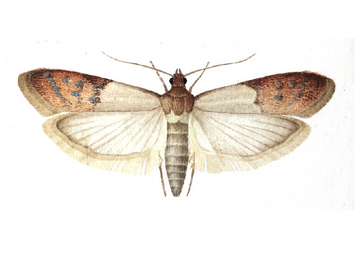Indianmeal moth
Plodia interpunctella, HÜBNER 1813
Appearance


The moths are about 8 mm in size when at rest, with their wings folded like a roof, and are easily recognized by their creamy-yellow forewings with a reddish-brown outer half of the wing.
The larvae of the dried fruit moth are whitish in color and may have a reddish and greenish tinge. The head of the larvae is also brown and the entire body is greasy shiny. When fully grown, the larva is about 13 mm long.
Biology
The dried fruit moth belongs to the family of beetles (Pyralidae).
The life span of the moths is two to three weeks at room temperature with sufficient humidity (condensation). The moths mate immediately after hatching and lay 200-400 eggs.
The larvae live in a self-made quiver of spider threads, mainly in the outer layers of the stored material. After five to seven larval stages, a three to ten day migratory phase of the adult larvae to the site of their pupation occurs. This usually takes place in protected places such as cracks and crevices. In the pupal cocoon, the larvae may enter a developmental dormancy (diapause) of several months. This dormancy is triggered by poor conditions such as low temperatures, short day lengths, or high population densities. In Central Europe, development takes an average of five to six months and two generations occur annually - in warm areas, there may be many more generations. The dried fruit moth is not very sensitive to low temperatures, especially larvae can tolerate temperatures of -10 °C for a few days. Therefore, overwintering in unheated warehouses is possible. Temperatures above 30 °C impair development, high humidity and drinkable water favor fecundity, development and longevity of the moths.
Damage symptoms
In cereal products of all kinds, the caterpillars feed mainly on the germ, leaving the endosperm largely undamaged. Heavily infested stocks are streaked or covered with the webs of the caterpillars. The goods eventually clump together and are contaminated by droppings. The larvae produce conspicuous webs or clumps of webs in and on the surface of the stored stores.
Distribution
This storage pest is common around the world in human proximity: Grain stores, warehouses, silos, mills, food-producing plants, bakeries, and homes.
The wide food spectrum makes it easy for the dried fruit moth to colonize human stores. It was introduced into Central Europe through trade in the 19th century and, due to its polyphagous lifestyle, hardiness and resistance to cold, has now taken up residence in many warehouses, factory rooms of food-producing companies as well as households.
Propagation and transmission
Due to the free movement of goods, the dried fruit moth is a widespread storage pest worldwide.
Infestation in the home occurs less by flying in through an open window, but mostly by passive introduction via food or packaging material already infested with eggs or larvae.
Prevention and control
General hygiene measures
- Thorough cleaning of harvesting and transport machinery
- Thorough cleaning of storage areas (removal of junk and cleaning waste) before storage
- Destruction of already infested stocks
- Sealing of windows and doors with rubber lips and insect screens
- Insulating ceilings and walls to avoid condensation
- Plastering of gaps, cracks and porous walls, avoiding floorboards and wooden boarding with joints and gaps
- Cooling of the stored goods to 10-13 °C
- After thorough cleaning, treat empty storage rooms with spraying, fogging agents (contact insecticides), which will kill the moths. However, the caterpillars cannot be controlled with these agents due to their hidden lifestyle and robustness
Detection
- By setting pheromone traps, male moths are attracted and remain attached to the adhesive surfaces. In addition, store rooms should be checked for adult moths on walls and packing materials
Control
- Fumigation of infested stores
- Biological control by releasing the braconid wasp Habrobracon hebetor (see list of plant protection products approved in Austria). This parasite finds the moth larvae living hidden in the grain and can be used from a storage temperature of 13 °C.
- Biological control by release of chalcid wasps of the species Trichogramma evanescens (see list of plant protection products approved in Austria). These egg parasites are only 0.3 - 0.4 mm small and have an excellent sense of smell, which they use to detect the eggs of dried fruit moths in storage. Trichograms are particularly suitable for use in high-bay and pallet warehouses, bakeries and households.
Tips for household use
- Store food only in well-sealing storage containers with rubber seals or screw caps
- Dispose of all infested food directly in the waste garbage can outside the home
- Remove moths fluttering or sitting around with a vacuum cleaner
- Infestation control is possible by means of pheromone traps from drugstores or hardware stores and is recommended in the case of regular infestations in the past, especially in autumn
- Fly screens on (roof) windows, doors and skylights reduce the risk of infestation
- If you have to fight with dried fruit moths again and again, ichneumon wasps can help. These are natural enemies of the moths and are simply released in the kitchen(Habrobracon hebetor see list of plant protection products approved in Austria).
Literature
Johnson, Judy & Wofford, P. & Gill, R. (1995). Developmental Thresholds and Degree-Day Accumulations of Indianmeal Moth (Lepidoptera: Pyralidae) on Dried Fruits and Nuts. Journal of Economic Entomology. 88. 734-742. doi 10.1093/jee/88.3.734.
Last updated: 06.09.2024
automatically translated